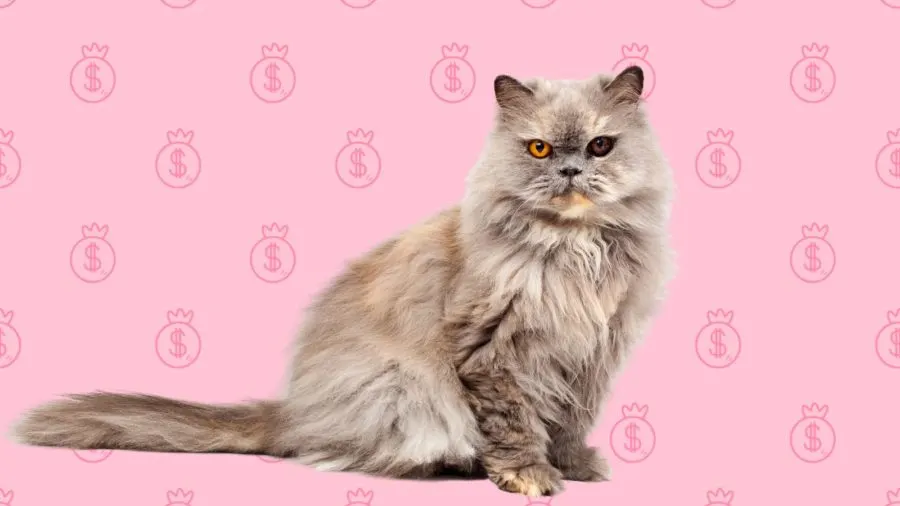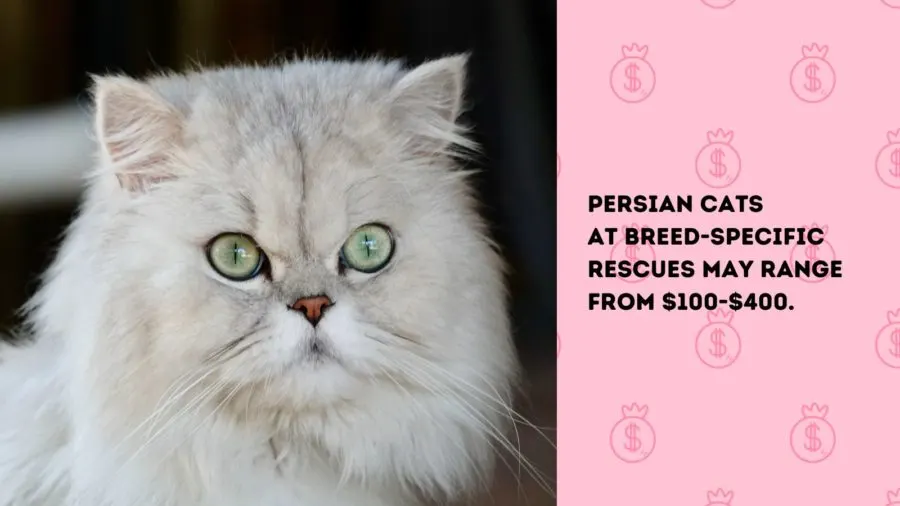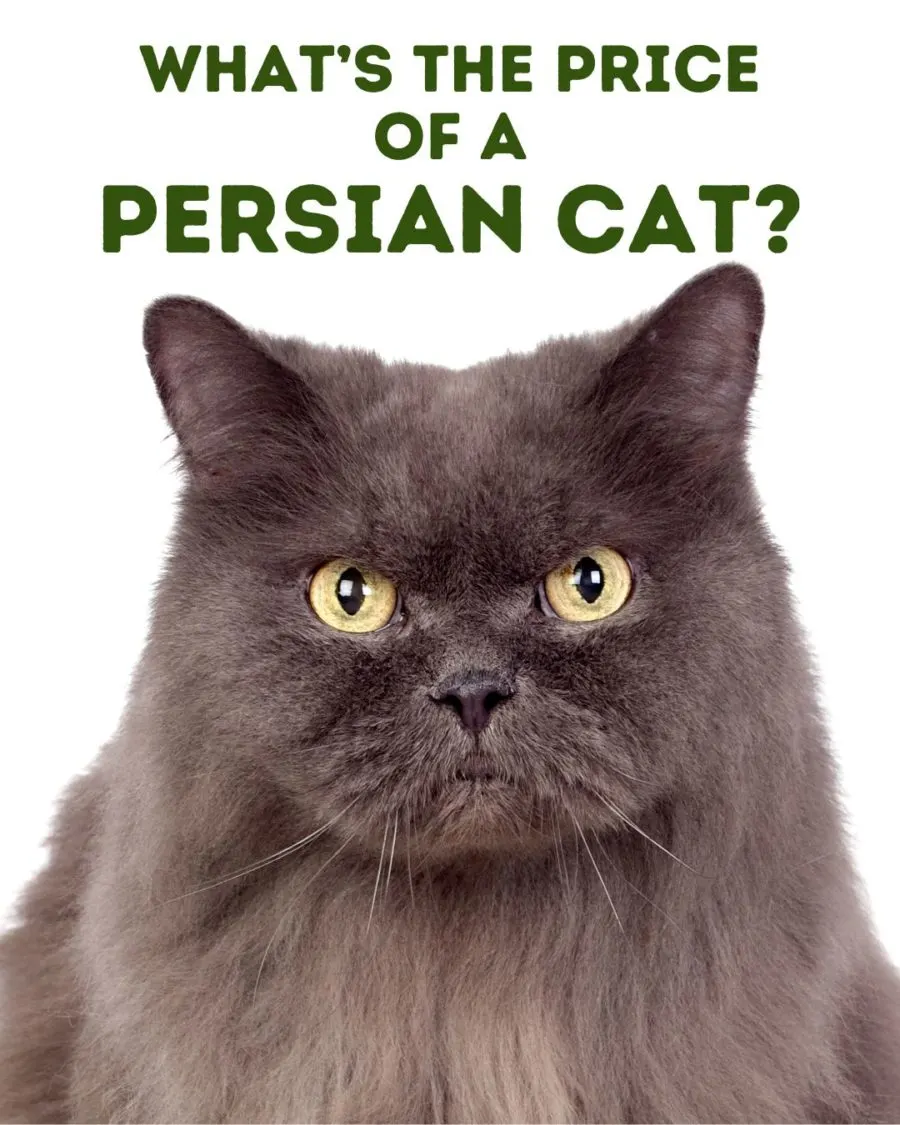Are you considering adding a Persian cat to your home and heart? Known for their luxurious long coats, distinctive flat faces, and serene demeanor, Persians are a popular choice for cat lovers. The price of a Persian cat varies greatly depending on whether you are looking at breeders specializing in Persians, breed-specific rescues offering rehabilitated cats or animal shelters with a range of mixed and purebred Persians. Each avenue provides its own set of considerations, ensuring that you make an informed and compassionate choice in welcoming a Persian cat into your life.

Price of a Persian Cat at a Breeder
Persian cat breeders demand the highest price for cats and kittens, ranging from about $1,000 to $1,800.
Choosing a reputable breeder not only assures a well-socialized and health-screened cat but also provides an opportunity to gain insights into the breed’s unique characteristics and needs. This route often involves higher costs due to the breeders’ commitment to maintaining the health, pedigree, and breed standards of the Persian cats.
The cost of a Persian cat from a breeder can vary significantly based on several factors:
Genetic Testing of the Parents: Reputable breeders often conduct genetic testing on the Persian cat’s parents. Cats with a clear bill of health and registrations, such as those from the Cat Fanciers’ Association (CFA) or other feline health organizations, are generally more expensive.
Location of the Breeder: The cost can vary depending on where the breeder is located. In metropolitan areas or places where Persian cats are less common, prices may be higher due to increased demand.
Pedigree of the Parents: Persian cats with a lineage of champions or cats that have won titles in cat shows command higher prices. Their kittens are often considered more desirable for show or breeding purposes.
Quality of the Cat: Similar to dogs, Persian cats can be categorized as show quality, breeding quality, or pet quality. Show quality Persians, which conform closely to breed standards, are typically the most expensive. Breeding quality cats, while still high-quality, might have minor differences that disqualify them from show rings but are still suitable for breeding. Pet quality Persians are typically less expensive and are sold on the agreement that they will be spayed or neutered.
Age of the Cat: The price of a Persian kitten is usually more than adult cats, as they are in higher demand.
Coat Color and Patterns: Persian cats come in various colors and patterns, and some are rarer than others. For instance, solid colors like white, black, or blue, or rare patterns like chinchilla or shaded may be priced higher than more common colors or patterns.
When purchasing a Persian cat from a breeder, the price usually includes registration papers, initial vaccinations, and sometimes a health guarantee. It’s essential to ensure that you are dealing with a reputable breeder and not a backyard breeder or an online seller. A responsible breeder will provide a healthy environment for the kittens, be transparent about their breeding practices, and be willing to answer questions about the health and lineage of their cats.
Health Tests for Persian Cats: Reputable breeders will often conduct health screenings on the parent cats to ensure they are not passing hereditary conditions to their offspring.
Responsible breeders may perform screenings for conditions common in Persians, such as polycystic kidney disease (PKD), hypertrophic cardiomyopathy (HCM), and respiratory issues due to their brachycephalic (flat-faced) nature. It’s important to inquire about these tests when considering purchasing a Persian cat.
Genetic testing with tests such as Optimum Selection Feline by Wisdom Panel helps identify carriers of numerous diseases and conditions including several recently added that have been discovered in Persian cats including Chediak-Higashi Syndrome (a rare genetic disorder characterized by abnormal immune function, light-colored fur, and increased susceptibility to infections and bleeding disorders) and Progressive Retinal Atrophy (a hereditary disease that causes gradual deterioration of the retina, leading to eventual blindness).
The International Cat Association has a registry of Persian cat breeders. The CFA Persian Breed Council has a list of regional groups and more.
Adopting a Persian Cat from a Breed-Specific Rescue

Persian cats adopted from breed-specific rescues in the United States are typically less expensive than those purchased from breeders. Generally, the adoption fee for a Persian cat at a rescue can range from $100 to $400, depending on factors like location, age, and the cat’s specific needs. Kittens under a year old are usually the most expensive due to higher demand.
A breed rescue is a specialized pet rescue focusing on a single breed, in this case, Persian cats. These rescues often have purebred Persians and mixes, providing an opportunity to adopt these distinctive cats.
These rescues are typically small, non-profit organizations operating through a network of volunteers passionate about the breed. The foster care system they use allows the cats to live in a home environment while waiting for adoption, giving the foster families a chance to understand and share the cat’s personality, preferences, and ideal home environment.
In addition to Persian-specific rescues, it’s also worthwhile to check with other cat breed rescues, as Persians sometimes turn up in broader cat rescue organizations.
Upon adopting a Persian cat from a breed rescue, you can expect the cat to have received several important health and wellness services. The goal of these tests and treatments is to ensure that the cat is healthy and ready for a new home, reducing the risk of transmitting any diseases and addressing any health concerns before adoption.
The specific tests and treatments can vary depending on the rescue’s resources and the cat’s individual needs, but typically include the following:
Health Examination: A thorough physical examination is conducted to check for any signs of illness, injury, or congenital defects.
Vaccinations: Cats are vaccinated against common feline diseases. This often includes vaccines for feline distemper (panleukopenia), calicivirus, rhinotracheitis (herpesvirus), and rabies.
Feline Leukemia (FeLV) and Feline Immunodeficiency Virus (FIV) Testing: These are vital tests as both conditions are common in cats and can affect their long-term health. FeLV affects the cat’s immune system, while FIV is similar to HIV in humans.
Deworming: Cats are routinely treated for internal parasites like roundworms, hookworms, and tapeworms.
Flea and Tick Treatment: Preventative treatments for fleas and ticks are often provided, especially if the cat had any infestation when rescued.
Spaying or Neutering: Most rescues spay or neuter cats before adoption to help control the pet population.
Microchipping: Many rescues microchip cats before adoption. This is a form of permanent identification in case the cat gets lost.
Dental Check: Some rescues provide a dental examination to check for signs of dental disease or other oral issues.
Behavioral Assessment: While not a medical test, behavioral assessments are often conducted to understand the cat’s personality, preferences, and any potential behavioral issues.
Heartworm Testing and Prevention: While less common in cats than dogs, some rescues might test for heartworm and provide preventative care.
Ear Mite Treatment: If the cat has signs of ear mites, they will be treated for this condition.
Other Specific Tests or Treatments: Depending on the cat’s condition upon rescue, additional tests like blood work, urine analysis, or specific treatments for illnesses or injuries might be conducted.
The cost of these services, if done independently, could start from $300-$500 and more, making rescue adoption a financially sensible choice.
To find Persian cat rescues, you can search for “Persian cat rescue near me” or look at large adoption sites like 24Petconnect, AdoptAPet, Petango, and PetFinder, specifically for Persian cats or cat breed rescues in your area.
Rescues such as South Texas Persian Rescue, Helping Persian Cats, No Rulz Persian Rescue Crew and others specialize in Persian cats.
If you find a potential match, you will apply directly to the rescue. These rescues often have rigorous adoption processes to ensure a good fit for both the cat and the adopter, which may include a home visit, veterinary check, and reference checks.
Persian cats in rescues may be there for various reasons, including owner surrenders, changes in living situations, or being found as strays. Some may come with papers if they were surrendered with them, but this is not always the case.
Adopting a Persian cat from a rescue can be a cost-effective and rewarding way to bring a new feline companion into your home, with the added benefit of knowing you are providing a cat in need with a loving home.
Adopting from a Shelter
When seeking an affordable option for adopting a Persian cat, shelters are your go-to choice. These can be either municipal animal shelters or privately-operated ones. The cost of adopting a cat from a municipal shelter typically ranges between $50 to $150. In privately-operated shelters, the price may be slightly higher, reflecting the additional care and services they provide.
At these shelters, or when browsing online listings, your knowledge about Persian cats becomes crucial. Not every cat listed as a Persian may truly be one. Shelters do their best to identify breeds accurately, but this can be challenging given the volume of animals they handle.
To increase your chances of finding a genuine Persian cat, consider the following tips:
- Familiarize yourself with Persian cat features at various life stages. Visit breeder websites or the breed club to understand how Persians look as kittens, young adults, and mature cats.
- Note the distinctive long, luxurious coat typical of Persians. This breed is known for its thick, plush fur.
- Look for the breed’s unique facial structure. Persians are famous for their flat faces and large, round eyes.
- Check for a calm and gentle demeanor, as Persians are known for their laid-back and affectionate nature.
In shelters, most cats, including Persians, will have undergone essential veterinary care, including spaying/neutering, vaccinations, deworming, and microchipping. These services, if paid for separately, can cost between $350 to $500.
To find a Persian cat in a shelter, start by contacting local shelters or searching online platforms like Petfinder. You can filter your search by breed, age, gender, and even location. While shelters primarily house their animals on-site, an increasing number use foster homes, especially for kittens, allowing you to learn more about the cat’s personality from the foster caretaker.
Inquiring with shelter staff is also beneficial. They can provide insights into a cat’s temperament and any past history the shelter might know.
Finally, adopting a Persian cat from a shelter not only saves the life of the cat you bring home but also frees up space for another animal in need. While the history and pedigree of shelter cats may not always be clear, the joy and companionship they offer are invaluable.
Related Posts
200+ Persian Cat Names – Fluffy, Fanciful, and Fun!
Cat Terms: A Glossary for Cat Lovers
Pin it to remember

- 🎉 GIVEAWAY: Lord of the Pets Portrait of Your Cat! - November 26, 2024
- Review: Lord of the Pets Cat Portraits! - November 26, 2024
- Cat Adoption: FAQ You Might Have - June 28, 2024
